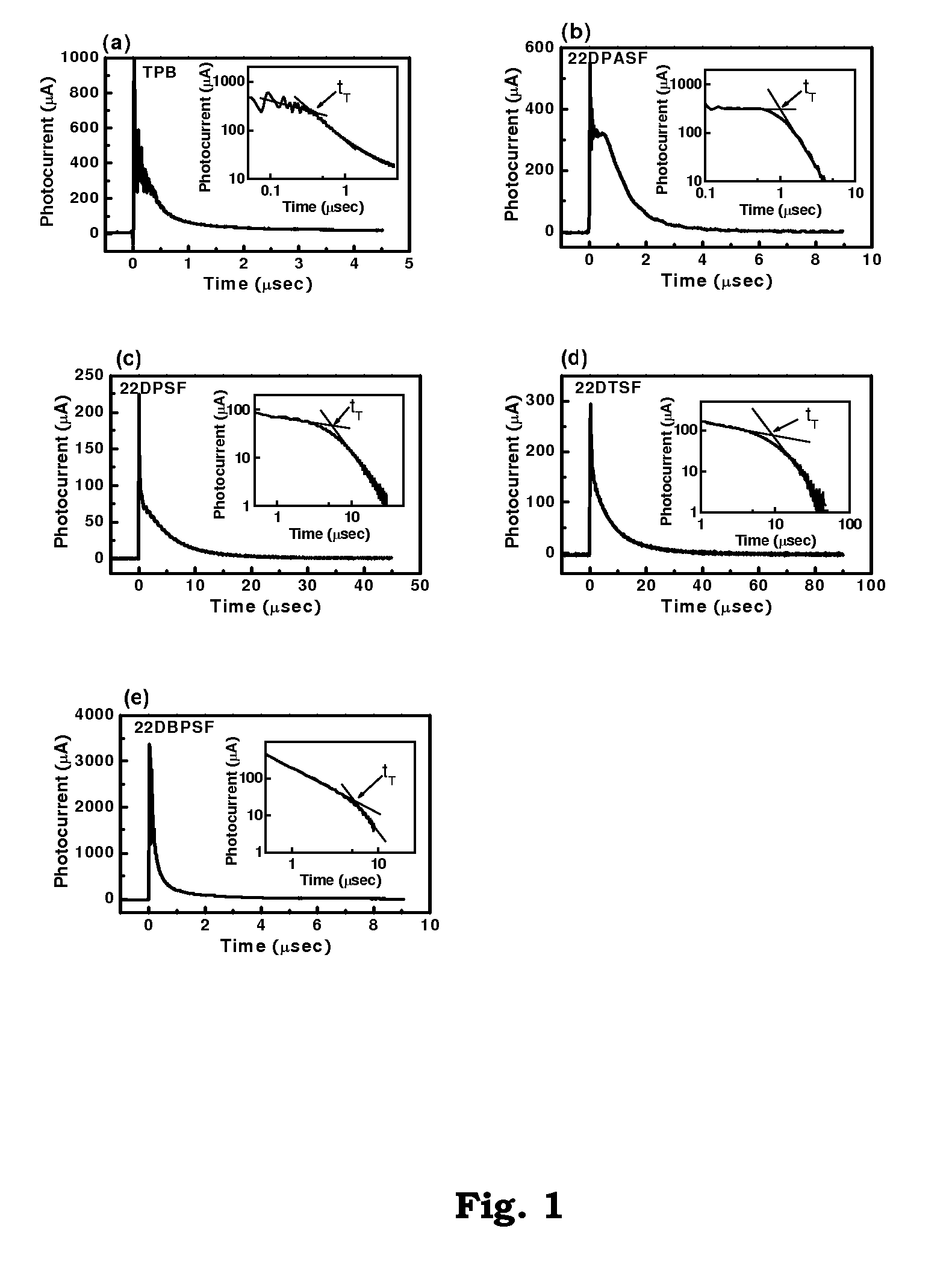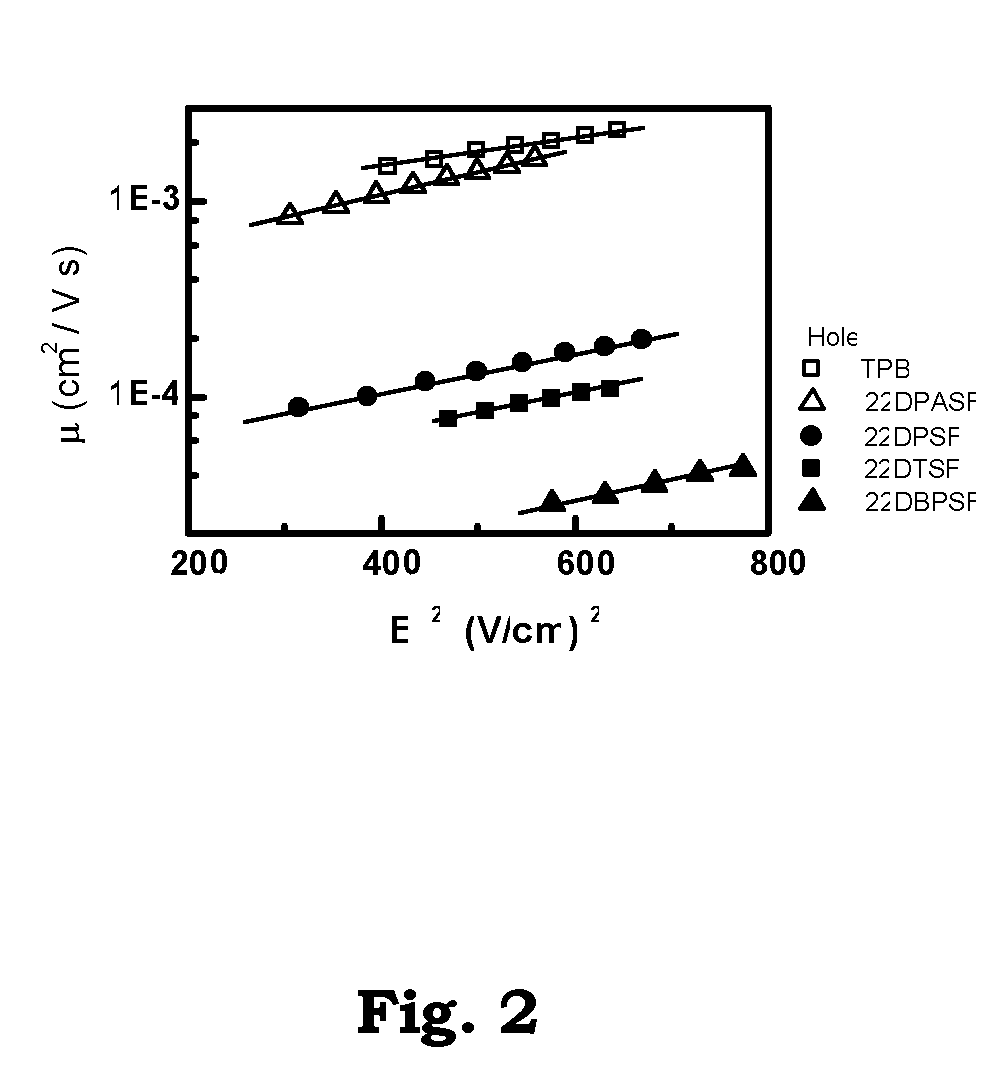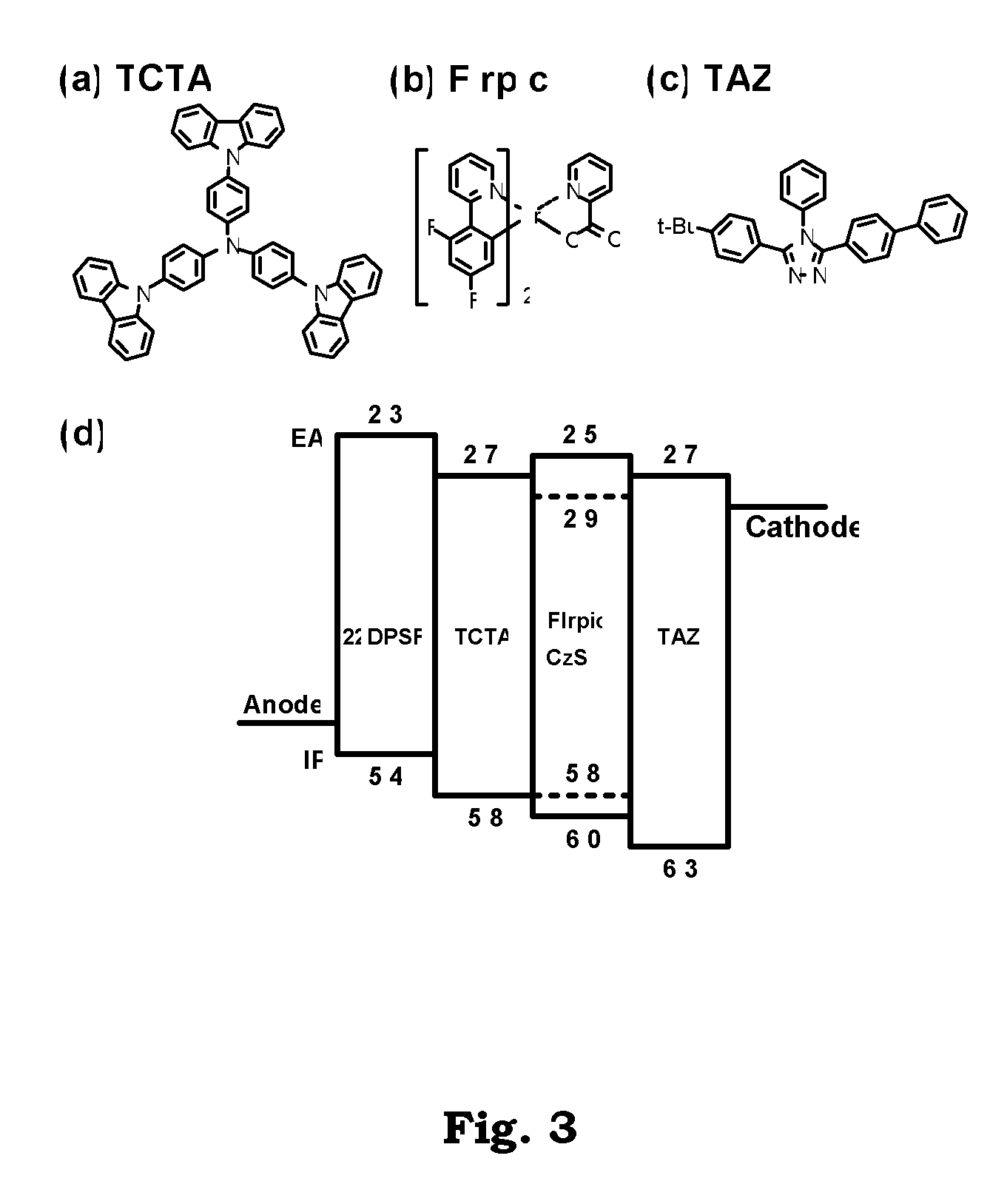2-2′-disubstituted 9,9′-spirobifluorene-base triaryldiamines and their application
a technology of spirobifluorene and triaryldiamine, which is applied in the field of spirobifluorene derivatives, can solve the problems of difficult separation of isomers, difficult preparation and isolation of pure 2,2′-dibromo-9,9′-spirobifluorene, and many plagues of sandmeyer reactions, etc., and achieves simple manner. , the effect of easy practi
- Summary
- Abstract
- Description
- Claims
- Application Information
AI Technical Summary
Benefits of technology
Problems solved by technology
Method used
Image
Examples
example 1
Synthesis of 22DPSF [2,2′-Bis(diphenylamino)-9,9′-spirobifluorene]
[0017]
[0018]2,2′-diamino-9,9′-spirobifluorene (3.46 g, 10 mmol), iodobenzene (6.8 mL, 60 mmol), Pd(OAc)2 (0.112 g, 0.5 mmol), sodium-tert-butoxide (14.4 g, 150 mmol) and tri-tert-butylphosphine (20 mL, 0.05 M in toluene, 1.0 mmol) were mixed in a flask containing with toluene (100 mL). The mixture was refluxed overnight. The solution was quenched with water and extracted twice with chloroform. The combined organic extracts were dried over MgSO4 and concentrated by rotary evaporation. Column chromatography on silica gel (hexane / chloroform=4 / 1) afforded products [2,2′-Bis(diphenylamino)-9,9′-spirobifluorene, hereinafter named as 22DPSF] as a white solid (4.5 g, 70%).
[0019]22DPSF: m.p. 136˜138° C.; IR (neat) □ 3071, 3045, 1593, 1493, 1440, 1295 cm−1; 1H NMR (CDCl3, 400 MHz) δ 7.66 (d, J=7.5 Hz, 2H), 7.61 (d, J=8.1 Hz, 2H), 7.29 (t, J=7.5 Hz, 2H), 7.18˜7.14 (m, 4H), 7.06 (t, J=7.5 Hz, 2H), 7.00˜6.92 (m, 7H), 6.74 (d, J=7....
example 2
Synthesis of 22DTSF [2,2′-bis(ditolylamino)-9,9′-spirobifluorene]
[0020]
[0021]22DTSF: 2,2′□-Diamino-9,9′-spirobifluorene (3.46 g, 10.0 mmol), 4-iodotoluene (13.1 g, 60.0 mmol), Pd(OAc)2 (0.112 g, 0.5 mmol), sodium-tert-butoxide (14.4 g, 150.0 mmol) and tri-tert-butylphosphine (1.0 mmol) were mixed in a flask containing with toluene (50.0 mL). The mixture was refluxed overnight. The solution was extracted twice with toluene. The combined organic extracts were dried (MgSO4) and concentrated by rotary evaporation. Column chromatography on silica gel (hexane / chloroform=5 / 1) afforded products as white solids 22DTSF (5.9 g, 72%).
[0022]mp 259˜260° C.; IR (neat) □□3032 (w), 2925 (w), 1606 (s), 1500 (s), 1447 (s), 1314 (s), 1295 (s) cm−1; 1H NMR (d6-DMSO, 400 MHz) δ 7.77˜7.73 (m, 4H), 7.29 (t, J=7.4 Hz, 2H), 7.06˜6.99 (m, 10H), 6.83 (d, J=8.3 Hz, 2H), 6.76 (d, J=7.5 Hz, 8H), 6.58 (d, J=7.5 Hz, 2H), 6.25 (s, 2H), 2.20 (s, 12H); 13C NMR (CDCl3, 100 MHz) δ 149.8, 148.9, 147.7, 145.3, 141.3, 136....
example 3
Synthesis of 22DBPSF [2,2′-bis[di-(4-t-butylphenyl)amino]-9,9′-spirobifluorene]
[0023]
[0024]22DBPSF: 2,2′-Diamino-9,9′-spirobifluorene (3.46 g, 10.0 mmol), 4-bromo-tert-butylbenzene (10.6 mL, 60.0 mmol), Pd(OAc)2 (0.112 g, 0.5 mmol), sodium-tert-butoxide (14.4 g, 150.0 mmol) and tri-tert-butylphosphine (1.0 mmol) were mixed in a flask containing with toluene (50.0 mL). The mixture was refluxed 48 hours. The solution was extracted twice with chloroform. The combined organic extracts were dried (MgSO4) and concentrated by rotary evaporation. Column chromatography on silica gel (hexane / chloroform=6 / 1) afforded products as white solids 22DBPSF (5.3 g, 60%).
[0025]mp 286˜287° C.; IR (neat) □ 3032 (w), 2925 (w), 1606 (s), 1500 (s), 1447 (s), 1314 (s), 1295 (s) cm−1; 1H NMR (CDCl3, 400 MHz) δ 7.64 (d, J=7.6 Hz, 2H), 7.58 (d, J=8.2 Hz, 2H), 7.28 (t, J=7.5 Hz, 2H), 7.16 (d, J=8.7 Hz, 8H), 7.05 (t, J=7.5 Hz, 2H), 6.96 (d, J=8.2 Hz, 2H), 6.90 (d, J=8.7 Hz, 8H), 6.74 (d, J=7.6 Hz, 2H), 6.66 (s, 2...
PUM
| Property | Measurement | Unit |
|---|---|---|
| glass transition temperature | aaaaa | aaaaa |
| pressure | aaaaa | aaaaa |
| deposition rate | aaaaa | aaaaa |
Abstract
Description
Claims
Application Information
 Login to View More
Login to View More - R&D
- Intellectual Property
- Life Sciences
- Materials
- Tech Scout
- Unparalleled Data Quality
- Higher Quality Content
- 60% Fewer Hallucinations
Browse by: Latest US Patents, China's latest patents, Technical Efficacy Thesaurus, Application Domain, Technology Topic, Popular Technical Reports.
© 2025 PatSnap. All rights reserved.Legal|Privacy policy|Modern Slavery Act Transparency Statement|Sitemap|About US| Contact US: help@patsnap.com



